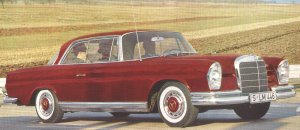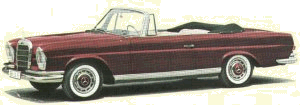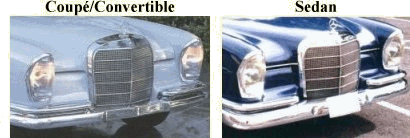
|
 |
 The 220SE Coupé was
shown to the press at Stuttgart in February 1961 on occasion of the re-opening of the
Daimler-Benz Museum. It was also the year that Mercedes celebrated its 75 years of
existense so you could call the Coupé a real anniversary car. The car made his public
debut a month later at the 1961 Geneva Show were it had to compete with the E-type from
Jaguar. The Convertible appeared some months later at the Frankfurt Show. The 220SE Coupé was
shown to the press at Stuttgart in February 1961 on occasion of the re-opening of the
Daimler-Benz Museum. It was also the year that Mercedes celebrated its 75 years of
existense so you could call the Coupé a real anniversary car. The car made his public
debut a month later at the 1961 Geneva Show were it had to compete with the E-type from
Jaguar. The Convertible appeared some months later at the Frankfurt Show.
|
 Like all open cars, the
Convertibles had their own special appeal. The styling of Bracq ensured that they looked
equally good with the top up or down, which you can't say about other Convertibles. Like
the Ponton A Convertibles, they carried their tops in a recess just behind the rear seat,
so that only a small amount of fabric and foling mechanism protruded above the bodywork,
to be covered by a tightly-fitting bag. The Convertible is not just an open Coupé, if you
look closely you will see that the grille of a Convertible is set at a different angle
than the grille of a Coupé (the grille of a Coupé stands more upright than the grille of
a Convertible). Like all open cars, the
Convertibles had their own special appeal. The styling of Bracq ensured that they looked
equally good with the top up or down, which you can't say about other Convertibles. Like
the Ponton A Convertibles, they carried their tops in a recess just behind the rear seat,
so that only a small amount of fabric and foling mechanism protruded above the bodywork,
to be covered by a tightly-fitting bag. The Convertible is not just an open Coupé, if you
look closely you will see that the grille of a Convertible is set at a different angle
than the grille of a Coupé (the grille of a Coupé stands more upright than the grille of
a Convertible).
|

|
|

|
  The wheels of the 220SE Coupés and Convertibles were, of
course, the same as for the 220SE sedans. Not just simple looking wheels but elegant
chromed rims with 12 holes. If the car had a two-tone colour paint finish, the hubcaps
were painted in the upper body colour. The hubcaps of the 220SE models were detachable
from the rims. Early 300SE Coupés and Convertibles have similar wheels. The wheels of the 220SE Coupés and Convertibles were, of
course, the same as for the 220SE sedans. Not just simple looking wheels but elegant
chromed rims with 12 holes. If the car had a two-tone colour paint finish, the hubcaps
were painted in the upper body colour. The hubcaps of the 220SE models were detachable
from the rims. Early 300SE Coupés and Convertibles have similar wheels.
Later 280SE Coupés and Convertibles have also similar looking wheels but the complete
wheelcover is now made out of one-piece.
|
  When placing the front of a sedan and that of a
Coupé/Convertible next together you can clearly see the family resemblance. Both models
share a similar looking grille and headlights. The only real noticeable difference is that
the bumpers of the Coupé/Convertible are somewhat more elegant and they miss the little
chrome strips between the headlights and the grille. When placing the front of a sedan and that of a
Coupé/Convertible next together you can clearly see the family resemblance. Both models
share a similar looking grille and headlights. The only real noticeable difference is that
the bumpers of the Coupé/Convertible are somewhat more elegant and they miss the little
chrome strips between the headlights and the grille.
|
  Mercedes decided in 1963 to give all the sedans, Coupés and
Convertibles of that time a small face-lift, some minor details on the cars give away
their 'before' and 'after' look. One of those details was that the rearview mirror moved
from its place on the front wing to a place nearer the driver on the front door. This was
done so that adjusting the mirror could be easily done from sitting in the seat. The
design of the rearview mirror changed slightly with the introduction of the 280SE Coupés
and Convertibles (see chapter 6) 1967: The 280SE Coupé and
Convertible). Mercedes decided in 1963 to give all the sedans, Coupés and
Convertibles of that time a small face-lift, some minor details on the cars give away
their 'before' and 'after' look. One of those details was that the rearview mirror moved
from its place on the front wing to a place nearer the driver on the front door. This was
done so that adjusting the mirror could be easily done from sitting in the seat. The
design of the rearview mirror changed slightly with the introduction of the 280SE Coupés
and Convertibles (see chapter 6) 1967: The 280SE Coupé and
Convertible).
|
  Of course the Coupé/Convertible models had to incorperate the
same novelties that could be found on the sedan models. The air-outlets on the C-pillar of
the sedans (see chapter 3) 1959: The 220, 220S and 220SE models)
were put there to let the air flow out of the interior but because the
Coupés/Convertibles did not have this air-outlet, used air could leave the interior
compartement via the rear window (see picture). Of course the Coupé/Convertible models had to incorperate the
same novelties that could be found on the sedan models. The air-outlets on the C-pillar of
the sedans (see chapter 3) 1959: The 220, 220S and 220SE models)
were put there to let the air flow out of the interior but because the
Coupés/Convertibles did not have this air-outlet, used air could leave the interior
compartement via the rear window (see picture).
|
  Cars destined for the US markets differed slightly from
the European cars. Not only did the US cars have the 'sealed-beam' headlights but the
placement of the rear numberplate lighting was also different (see picture). European cars
have their numberplate lighting placed directly beneath the numberplate, incorporated in
their rear bumper. US cars have two single lights placed on the left and right of the
numberplate. Cars destined for the US markets differed slightly from
the European cars. Not only did the US cars have the 'sealed-beam' headlights but the
placement of the rear numberplate lighting was also different (see picture). European cars
have their numberplate lighting placed directly beneath the numberplate, incorporated in
their rear bumper. US cars have two single lights placed on the left and right of the
numberplate.
|